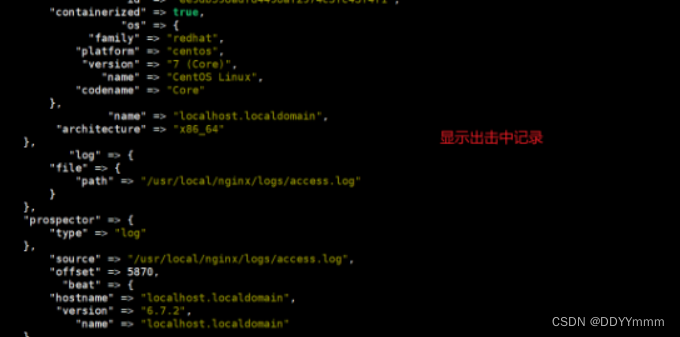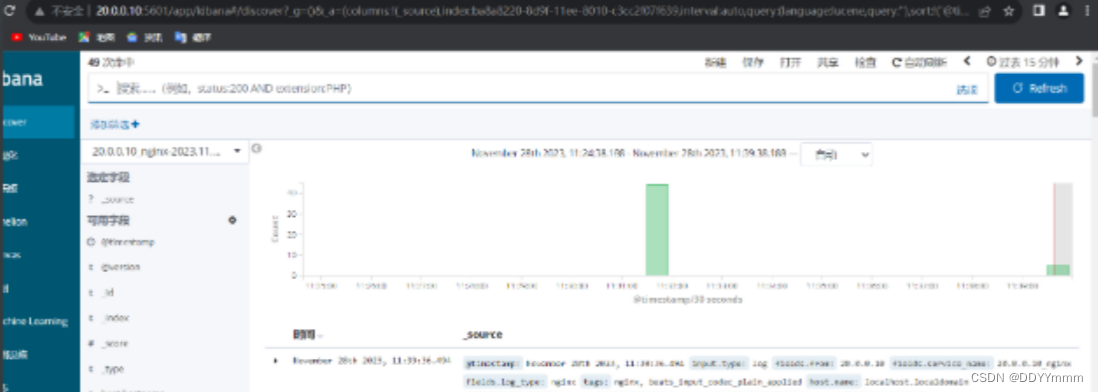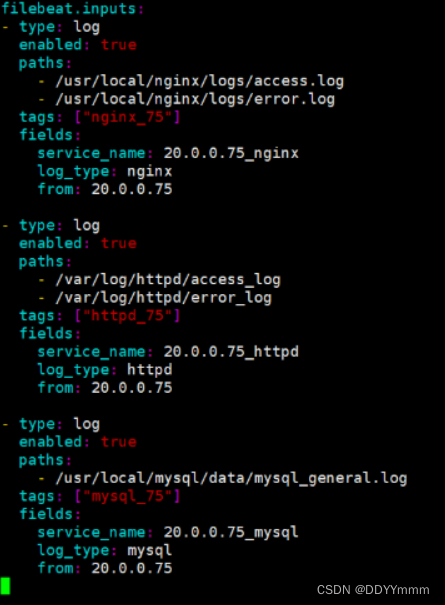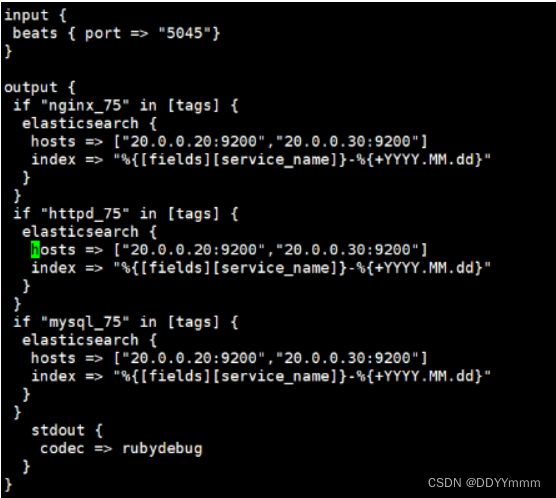ELK----filebeat日志收集工具
ELK:filebeat日志收集工具和logstash相同
filebeat是一个轻量级的日志收集工具,所使用的系统资源比logstash部署和启动时使用的资源要小的多。
filebeat可以运行在非java环境。他可以代理logstash在非java环境上收集日志
filebeat无法实现数据的过滤,一般是结合logstash的数据过滤功能一块使用
filebeat收集的数据可以发往多个主机。远程收集。
数据流程图:

实验:
20.0.0.10:logstash+kibana+filebeat
20.0.0.20:es1
20.0.0.30:es2
20.0.0.75:mysql
?
?
vim /etc/logstash/logstash.yml
64行
path.data: /opt/log
重启服务即可
?
yum -y install ntpdate
#时间同步
ntpdate ntp.aliyun.com?
?
yum -y install nginx
#安装nginx
开启nginx
vim /usr/local/nginx/html/index.html
this is nginx
?
到浏览器页面访问测试一下
20.0.0.10:8080
?
回到10主机
cd filebeat
cp filebeat.yml filebeat.yml.bck
vim filebeat.yml
Logstash output部分
output.logstash:解除注释
hosts: ["20.0.0.10:5044"]解除注释
?15 filebeat.inputs:
?16 - type: log
?17 ? enabled: true
?18 ? paths:
?19 ? ? - /usr/local/nginx/logs/access.log
?20 ? ? - /usr/local/nginx/logs/error.log
?21 ? tags: ["nginx"]
?22 ? fields:
?23 ? ? service_name: 20.0.0.10_nginx
?24 ? ? log_type: nginx
?25 ? ? from: 20.0.0.10
?
? cd /opt/log
? vim nginx.conf
? input {
? ?beats { prot => "5044"}
? }
??
? output {
? ? if "nginx" in [tags] {
? ? ? elasticsearch {
? ? ? ? hosts => ["20.0.0.20:9200","20.0.0.30:9200"]
? ? ? ? index => "%{[fields][service_name]}"-%{+YYYY.MM.dd}
? ? ? }
? ? }
? ? stdout {
? ? ? codec => rubydebug
? ? }
? }
nohup ./filebeat -e -c filebeat.yml > filebeat.out &
? #nohup表示在后台记录执行命令的过程
? #./filebeat运行文件
? #-e使用标准输出同时禁用syslog文件输出
? #-c指定配置文件
? cd /opt/log
? logstash -f file_nginx.conf --path.data /opt/ng3 &


到浏览器测试一下


logstash收集日志的过程:
input(从哪收集)
filter(过滤)
output(发送es实例)
?
远程收集多个日志
MySQL主机
vim /etc/my.conf
general_log=ON
general_log_file=/usr/local/mysql/data/mysql_general.log
#开启日志功能和指定日志位置
systemctl restart mysqld.service
#重启MySQL服务
打开MySQL进入创建一个库和一个表给日志创造一点信息
?
yum -y install httpd
#安装httpd服务
yum -y install nginx
#安装nginx服务
修改nginx的端口号为8080
?
到浏览器访问测试一下httpd和nginx
20.0.0.75:80
20.0.0.75:8080
?
在MySQL主机上安装filebeat
cd filebeat
cp filebeat.yml filebeat.yml.bak
vim filebeat.yml
打开optput
hosts: [20.0.0.10]
filebeat.inputs:
- type: log
? enabled: true
? paths:
? ? - /usr/local/nginx/logs/access.log
? ? - /usr/local/nginx/logs/error.log
? type: ["nginx_75"]
? fields:
? ? service_name: 20.0.0.75_nginx
? ? log_type: nginx
? ? from: 20.0.0.75
?
- type: log
? enabled: true
? paths:
? ? - /var/log/httpd/access.log
? ? - /var/log/httpd/error.log
? type: ["httpd_75"]
? fields:
? ? service_name: 20.0.0.75_httpd
? ? log_type: httpd
? ? from: 20.0.0.75
?
- type: log
? enabled: true
? paths:
? ? - /usr/local/mysql/data/mysql_general.log
? type: ["mysql_75"]
? fields:
? ? service_name: 20.0.0.75_mysql
? ? log_type: mysql
? ? from: 20.0.0.75
?
回到elk主机
cd /opt/log
vim nhm_75.conf
input {
?beats { port => "5045"}
}
?
output {
?if "nginx_75" in [tags] {
? elasticsearch {
? ?hosts => ["20.0.0.20:9200","20.0.0.30:9200"]
? ?index => "%{[fields][service_name]}-%{+YYYY.MM.dd}"
? }
?}
?if "httpd_75" in [tags] {
? elasticsearch {
? ?hosts => ["20.0.0.20:9200","20.0.0.30:9200"]
? ?index => "%{[fields][service_name]}-%{+YYYY.MM.dd}"
? }
?}
?if "mysql_75" in [tags] {
? elasticsearch {
? ?hosts => ["20.0.0.20:9200","20.0.0.30:9200"]
? ?index => "%{[fields][service_name]}-%{+YYYY.MM.dd}"
? }
?}
? ?stdout {
? ? codec => rubydebug
? }
}
?
回到MySQL主机
nohup ./filebeat -e -c filebeat.yml > filebeat.out &
?
回到elk主机
logstash -f nhm_75.conf --path.data /opt/nhm
?
回到MySQL主机修改端口号
hosts: ["20.0.0.75:5045"]
nohup ./filebeat -e -c filebeat.yml > filebeat.out &
?
到elk主机
logstash -f nhm.conf --path.data /opt/nhm2 &
?
到浏览器查看一下es索引是否创建成功
再到kibana上创建索引查看是否有日志记录







logstash性能优化:
logstash启动是在jvm虚拟机当中其中,启动一次至少500M内存。
vim /etc/logstash/logstash.yml
41行
pipeline.workers: 2
#定义了logstash的工作线程,默认值就是cpu数。4核最好给2,8核给2,给一半即可
pipline.batch.size: 125
#一次性批量处理检索时间的大小
#125是条数。可以根据自行修改
50行
pipeline.batch.delay: 50
#查询更新的延迟
#50是50毫秒,也可也自行调整
#生产中一般10-15毫秒。也要看机器性能
本文来自互联网用户投稿,该文观点仅代表作者本人,不代表本站立场。本站仅提供信息存储空间服务,不拥有所有权,不承担相关法律责任。 如若内容造成侵权/违法违规/事实不符,请联系我的编程经验分享网邮箱:veading@qq.com进行投诉反馈,一经查实,立即删除!